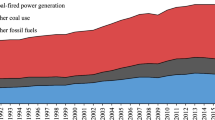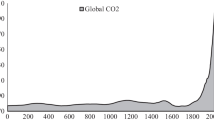Abstract
Recent research suggests that policies implementing structural change are required to alter the paths of carbon dioxide emissions in many nations. This note provides additional support for this view, allowing for smooth shifts in the deterministic part of the stochastic process. A Fourier wavelet unit root test indicates that in many countries, a temporary shock to emissions will have a permanent impact, whereas tests that examine fractional integration around a smooth break with de-trending indicate that a shock to emissions will have a transitory impact. Policies that induce structural changes are required to place emissions on a downward path.
Similar content being viewed by others
Notes
We thank an anonymous referee for suggesting we include a summary of the current literature: it is relegated to the Supplementary Appendix for brevity.
See Erdogan and Solarin (2021).
Here both the AIC and BIC are employed, with the maximum lag set following a revised version of Schwert (1989) given that the test is performed on the low-frequency component of the series which is half the length of the original variable (T). Hence the maximum lag was set as floor (12 ((T//2)/100)0.25).
In the case of the t test on the Fourier term this is two tailed test that could be positive or negative with similar quantiles on either side of the distribution.
For instance, Pata and Aydin (2022) examine G7 nations on a longer time span and find that CO2 emissions polices will have permanent effects in all nations. They also employ asymptotic critical values in their analysis which may also explain the differences. For brevity Table 1 only contains the bootstrapped probability values, extended information appears in the Supplementary Appendix.
References
Barassi M, Spagnolo N, Zhao Y (2018) Fractional integration versus structural change: testing the convergence of CO2 emissions. Environ Resource Econ 71:923–968
Boden T, Marland G, Andres R (1999) Global, regional and national fossil-fuel CO2 emissions (1751–2014) vol 2017. Carbon Dixoxide Information Analysis Center (CDIAC), Oak Ridge National Laboratory (ORNL), Oak Ridge
Dickey DA, Fuller WA (1979) Distribution of the estimates for autoregressive time series with a unit root. J Am Stat Assoc 74:427–431
Dolado J, Gonzalo J, Mayoral L (2002) A fractional Dickey–Fuller test for unit roots. Econometrica 70:1963–2006
Erdogan S, Solarin S (2021) Stochastic convergence in carbon emissions based on a new Fourier-based wavelet unit root test. Environ Sci Pollut Res 28:21887–21899
Fernandez-Amador F, Oberdabernig D, Tomberger P (2022) Do methane emissions converge? Evidence from global panel data on production- and consumption-based Emissions. Empir Econ 63:877–900
Omay T, Baleanu D (2021) Fractional unit-root tests allowing for a fractional frequency flexible Fourier form trend: predictability of Covid-19. Adv Differ Equ. https://doi.org/10.1186/s13662-021-03317-9
Palm F, Smeekes S, Urbain J (2011) Cross-sectional dependence robust block bootstrap panel unit root tests. J Econ 163:85–104
Pata U, Aydin M (2022) Persistance of CO2 emissions in G7 countries: a different outlook from wavelet-based linear and non-linear unit root tests. Environ Sci Pollut Res. https://doi.org/10.1007/s11356-022-23284-2
Romero-Avila D, Omay T (2022) Are CO2 emissions stationary after all? New evidence from nonlinear unit root tests. Environ Model Assess 27:621–643
Schwert W (1989) Tests for unit roots: a monte carlo investigation. J Bus Econ Statisics 7(2):147–159
Sephton P (2020) Mean reversion in CO2 emissions: the need for structural change. Environ Resour Econ 75(4):953–975
Sephton P (2022) Further evidence of mean reversion in CO2 emissions. World Dev Sustain. https://doi.org/10.1016/j.wds.2022.100021
Sephton P (2023) Finite sample lag adjusted critical values and probability values for the Fourier wavelet unit root test. Comput Econ. https://doi.org/10.1007/s10614-023-10458-4
Shahbaz M, Sinha A (2019) Environomental kuznets curve for CO2 emissions: A Literature Survey. J Econ Stud 46(1):106–168
Solarin S, Erdogan S, Bello M (2022) Convergence analysis of ammonia emissions by sector and fuel source in OECD countries from 1750 to 2019 using a new Fourier-centric wavelet approach. Environ Sci Pollut Res 29:74276–74293. https://doi.org/10.1007/s11356-022-21007-1
Author information
Authors and Affiliations
Contributions
All authors contributed equally to the study.
Corresponding author
Ethics declarations
Conflict of interest
The authors have no relevant financial or non-financial interests to disclose.
Additional information
Responsible Editor: Paul Raschky.
Publisher's Note
Springer Nature remains neutral with regard to jurisdictional claims in published maps and institutional affiliations.
Supplementary Information
Below is the link to the electronic supplementary material.
Rights and permissions
Springer Nature or its licensor (e.g. a society or other partner) holds exclusive rights to this article under a publishing agreement with the author(s) or other rightsholder(s); author self-archiving of the accepted manuscript version of this article is solely governed by the terms of such publishing agreement and applicable law.
About this article
Cite this article
Sephton, P., Omay, T. A note on CO2 emissions using two new tests. Empirica 50, 933–941 (2023). https://doi.org/10.1007/s10663-023-09584-x
Accepted:
Published:
Issue Date:
DOI: https://doi.org/10.1007/s10663-023-09584-x




